The Story of the Centre-Rail Line Laid over Mont Cenis in the Early Days of Railway Enterprise and the Further Development of the System
RAILWAYS OF EUROPE - 31
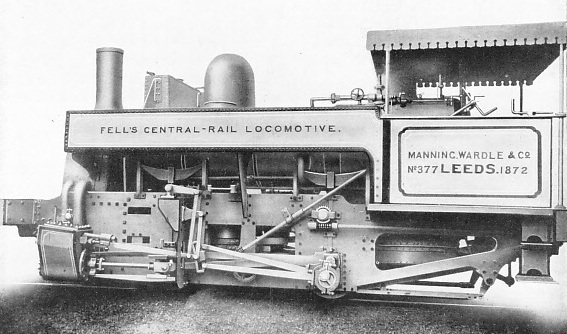
AN EARLY TYPE OF THE FELL CENTRE-RAIL LOCOMOTIVE
THE locomotive scarcely had become established upon the Continent of Europe when enterprising French engineers proposed that France and Italy should be connected by railway, so as to provide through direct communication between the North and the Mediterranean Seas. There was only one obstacle to interfere with the realisation of this dream, and that was one of extreme significance - the Alps. How to get through that barrier became a crucial question. The passes were probed through and through in the search for a feasible route, but notwithstanding the skill and resource of the engineers one fact became only too patent - the Alps could not be overcome unless a big tunnel were driven through the rampart. It is not surprising that the advocates of the idea in 1840 hesitated to commit themselves to boring the Alps. Such a tunnel as was demanded had never been attempted up to that time. So nothing beyond discussion was done for seventeen years.
At last, in 1857, the French and Italian authorities took their courage in their hands and commenced to pierce the Alps with a tunnel 8 miles in length. The point selected for the driving of the final link was the Col de Fréjus. It was a desperate undertaking, and its successful completion, after years of hard work and the subjugation of difficulties such as had never been encountered in railway construction up to this time, stands as an imperishable monument to the courage and skill of the French and Italian engineers.
But while the tunnel was in progress an English engineer had been working diligently upon an idea which had occurred to him, and which he maintained would eliminate the necessity to bore big tunnels. This was the late Mr. Fell. His conception was a decided innovation in railway practice. He described it as a “centre-rail” system, because between the ordinary two running rails he introduced a central third rail, available for adhesion, but in a manner different from anything then existing. The system must not be confused with the rack rail, wherein the face of the rail is provided with teeth, with which a cogwheel on the locomotive engages. The “Fell” is a pure adhesion system. There is a double-headed rail, laid horizontally instead of vertically. The locomotive, in addition to the ordinary carrying and driving wheels, is fitted with four horizontal wheels, two set on each side of the central rail, and in such a way as to run upon the two heads of the latter. This centre rail is placed 8 inches above the level of the running rails, so as to give the horizontal wheels sufficient clearance when running over points and switches.
The third rail is carried on steel chairs bolted to ordinary sleepers, the bolts passing through the web. In this manner the rail is fixed irremovably to the sleepers, and the whole of the permanent way is bound together in a most substantial and rigid manner. The number of the horizontal wheels may be varied according to the dimensions, weight, and power of the locomotive, but four have been found adequate as a rule. Each set of wheels has its own driving unit, one set of cylinders and pistons actuating the usual carrying and driving wheels, while the second set serves the horizontal wheels. The latter can be thrown in and out of action as required, so that the horizontal wheels are worked only when the centre-rail section of the road is entered. By this means it is possible to work grades up to 1 in 10 by adhesion purely and simply.
The system possesses advantages such as are not found in any other method of railway operation. Owing to the perfect grip, or adhesion, secured by the horizontal wheels, the revenue-earning factor is enhanced. A Fell centre-rail locomotive will haul nearly twice as much as an ordinary locomotive of equal weight and power, and at the same or greater speed. Derailment is impossible owing to the horizontal wheels running along the sides of the centre rail, the latter being held as if in a vice, while the braking system adopted - either manually or automatically operated - serves to hold the locomotive so steady and tightly upon the track that the latter must be torn up before the engine will leave it.
It has also been found, from actual experience, that with the centre-rail system there is much less friction on curves, and consequently reduced wear and tear on the tyres and flanges of the carrying wheels. The horizontal wheels take up the pressure due to centrifugal force, and keep the flanges from bearing and grinding against the outer rail. Another advantage of the idea is that guard rails are unnecessary because the horizontal wheels resist any climbing tendency on the part of the engine.
When Mr. Fell had perfected his idea he submitted it to some searching tests upon a length of line which was laid down upon his principle on the High Peak of Derbyshire with banks running up to as much as 1 in 10. These trials convinced the inventor of the complete feasibility of the system. The difficulty was to persuade railway engineers of its advantages - no easy matter in those days when railway engineering knowledge was somewhat scanty.
An opportunity arose in 1863. The Cenis Tunnel was in progress, but there was a heavy and increasing traffic which had to be maintained as efficiently as possible by means of diligences over the Cenis Pass. This slow method affected commercial interests very adversely, since the mails suffered considerable delay. Accordingly, Mr. Fell suggested that he should build a railway upon his system over the mountains to handle the traffic while the tunnel was being bored.
It was a daring proposal, inasmuch as it involved the construction of a line 50 miles in length, extending from St. Michel, the terminus of the the Paris, Lyons and Mediterranean Railway, a climb to an altitude of 7,000 feet and then a descent to gain the Alta-Italia Railways at Susa. The two governments entertained the proposal sympathetically, but thought it an experiment, and so were somewhat dubious of its success, seeing that it differed completely from existing practice. However, they did not reject it, but suggested that the promoters should build a trial line among the mountains and run it during the winter months. It was about as supreme a test as could be conceived, but it was accepted. A trial line, 1½ miles long, was laid down on the famous high-road zigzag known as Les Echelles, above Lanslebourg, at an altitude of 6,000 feet above sea level. On this section, owing to the contour of the mountain, a maximum grade of 1 in 12 had to be introduced, while the sharpest curve was of 132 feet radius. The road was tested very severely during the winter owing to the severity of the blizzards, and the following summer the inventor’s claims were more than substantiated. Accordingly, the French Government sanctioned the extension of the line from the Italian frontier to St. Michel, in November, 1865, while the Italian Government gave a similar concession to carry it through to Susa in the following month. But there was one proviso. The two nations, having sunk so much money in boring the tunnel, were resolved to suffer no competition from the overhead railway; it was to be abandoned upon the opening of the tunnel.
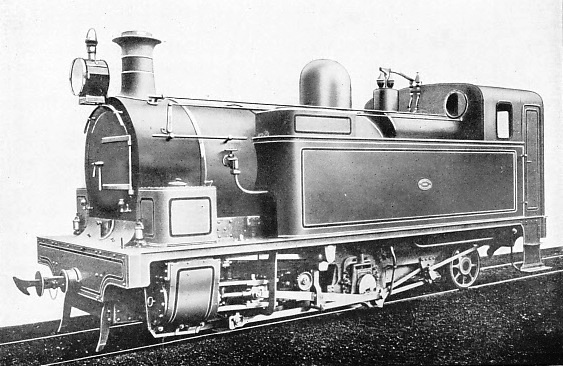
A RECENT TYPE OF THE FELL CENTRE-RAIL LOCOMOTIVE
A gauge of 3 feet 7½ inches was selected for the railway, this being cheaper to construct than the standard gauge, although it involved changing cars at Susa and St. Michel. The surveys showed that the steepest banks would be 1 in 10 and the sharpest curves of 132 feet radius. The promoters of the enterprise were permitted to follow the high road, and, in fact, were allowed to take a part of the latter for their right of way, so long as sufficient width was left for the diligences and other traffic.
As might be expected, railway building in such an exposed, wild mountainous country was not free from excitement and disaster. The builders clung as tightly as possible to the famous road built by Napoleon over Mont Cenis, some 12½ miles north-west of the tunnel - the latter is wrongly named - and work was commenced in 1866. Good progress was made up to the end of the year, but unfortunately the winter was abnormally severe. Such a low temperature prevailed that even the earthworks had to be carried out by blasting, while the holes for the posts of the fencing had to be sunk by explosives. Spring brought its own peculiar troubles in the shape of terrible floods, avalanches, and rock-slides. About 1½ miles of the track were wiped out of existence, several bridges were smashed; in fact, work had to be suspended entirely on the French side. Yet, despite these calamities, the last rail was laid on August 15th, 1867, and eleven days later the first train steamed from St. Michel to Susa over Mont Cenis.
Further troubles now developed. The locomotives had to be built in France, and were found so defective that they had to be rebuilt practically, so that the line could not be brought into service until June, 1868, on the fifteenth of which month the official inauguration took place amidst great rejoicings. The blind forces of Nature, as if infuriated at this human conquest, once more swept down, the floods washing away lengths of the line, breaking up the bridges, and wreaking devastation on every hand. Rock-slides were also of frequent occurrence, but the engineers overcame these visitations by throwing up massive masonry defences upon the mountain slopes-above the line.
Although the railway from end to end was a wonder of engineering, the most imposing feature was the negotiation of the great Echelle. Here the high road saws the mountain in a wonderful zigzag cut out of the face of the cliff. The railway followed the high road, but was forced to take the outer edge, so that passengers in the carriages looked sheer down for
1,000 feet into the yawning gulch. As the track could not be zigzagged in the manner of the high road, a kind of elaborate spiral was laid out, the tunnels being driven through the spurs at the end of each incline, so that the ascent was made in the manner of a big corkscrew, one level being immediately above the other. The passage of the Echelle provided the greatest thrill in the whole journey, as at places the sides of the cars overhung the cliff.
For three years this unique railway handled the whole of the international traffic - mail, goods, and passenger. During this period over 150,000 passengers were carried without a single fatality, and there was only one minor accident to a goods train. One stormy night the driver, in descending the incline, reversed his engine without first applying his brakes. The train got out of hand and the vehicles piled up in the ravine below, but the engine stuck to the rails.
Although the journey over the 50 miles occupied from 4½ to 5½ hours - including Customs examination at the frontier - the most outstanding feature was the reliability and punctuality of the service. Often the time which had been lost upon other parts of the various railways was more than made up on the Mont Cenis Fell section. The railway cost only £450,000 to build, an extraordinarily small sum when the mountainous character of the country traversed and the difficulties encountered are borne in mind. When compared with the outlay upon the big tunnel, which cost £5,320,000 to complete - £2,000,000 in excess of the estimates - the economical working of the system is emphasised more emphatically still. For the latter sum alone, a railway of standard gauge complying in every respect with trunk line conditions might have been built on the Fell system.
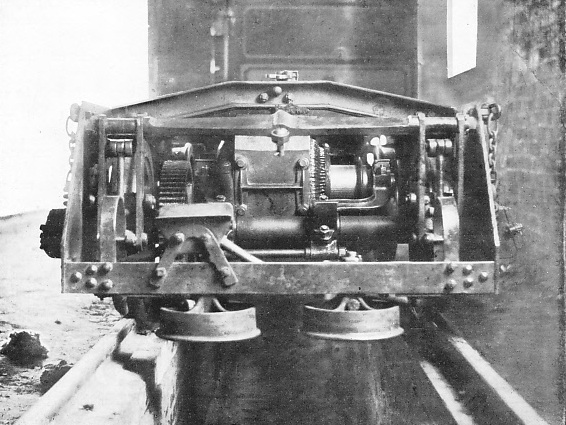
UNDERNEATH VIEW OF THE FELL ENGINE
Showing the horizontal wheels which grip the centre-rail.
Although the Fell railway had to be abandoned when the Cenis Tunnel was opened, the advantages of the system have received their due though tardy recognition. The growth of traffic between Italy and France has over-taxed the tunnel. Additional tracks have been suggested, but they would involve the driving of another big bore, as the existing tunnel and its approaches cannot be widened except at prohibitive cost. Accordingly the resuscitation of the Fell system is being discussed as the cheapest solution of the difficulty. The original line, after its term of duty was fulfilled, was taken up and sold to one of the railways which now forms a part of the Leopoldina system in South America, where it was laid down to lift the railroad over the coast range, which rises very abruptly. There is no doubt that had Mr. Fell completed his original experiments before 1852 the Cenis Tunnel never would have been built. Events have proved that it was a colossal mistake, due to the inability of the railway knowledge of the times to take the development of the steel-way into perspective. If the new Fell Railway is laid down it will be on the standard gauge, so that vehicles will be able to travel right through, engines only being changed at each end of the section, as is done even now to haul trains through the tunnel.
When the Wellington and Masterton Railway of New Zealand decided to extend its metals through the Rimutaka Pass, similar conditions to those prevailing in connection with Mont Cenis were presented. The railway engineers conceded that the only economical solution of the difficulty was to introduce the Fell Centre Rail through the Pass, where the banks run up to a maximum of 1 in 15 with curves of 330 feet radius. The traffic over this line is heavy, and it has been worked for over thirty years by Fell engines, weighing 41½ tons in running order, having a tractive force of 19,400 pounds, and capable of hauling a load behind them of 70 tons up the maximum bank, at 10 miles an hour.
T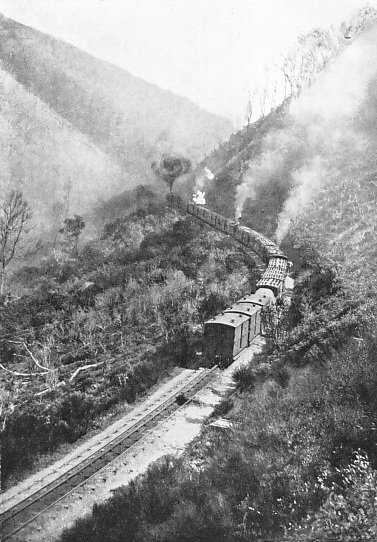 he system of working the traffic through this pass is interesting. As a rule the train is divided into sections, each having its own engine and all coupled together. In this manner each engine is caused to haul its own full load, and the couplings do
he system of working the traffic through this pass is interesting. As a rule the train is divided into sections, each having its own engine and all coupled together. In this manner each engine is caused to haul its own full load, and the couplings do
not have to withstand undue strains, such as would arise were a triple header and pusher system adopted. Thus it is by no means uncommon to see a train of twenty-eight vehicles, representing a dead load of 260 tons, with the locomotives disposed throughout the train, so that each hauls, seven vehicles, ascending the incline, for which duty a period of forty minutes is allowed.
THE FELL CENTRE-RAIL IN NEW ZEALAND
The train consists of 28 livestock cars, weighing 260 tons, and is being drawn through the Rimutaka Pass. Each engine hauls 7 cars. The rise is 1 in 15 with several curves of 330 feet radius.
Some idea of the work which these engines accomplish may be gathered from the fact that some 60,000 tons are put through this pass every year, and the average expense per locomotive is 5s. 10d. per train-mile, which represents about one penny per ton-mile. It is a moot point whether any other system could show such a low working cost under such conditions.
One accident happened upon this railway which emphasised the safety of the system very strikingly. During 1880 a violent storm raged, and in a very exposed part of the track the wind literally blew the train off the metals. A Fell engine was hauling, and another banking up the incline, but the hurricane failed to move them from the track. This fact saved the whole train from disaster, as otherwise it would have been hurled down the mountain side; and although several passengers lost their lives, the calamity would have been far more terrible had the whole train gone overboard, as would have been the case had there been no centre rail, which the engines, owing to the horizontal wheels and braking system, gripped as if in a vice.
There is one interesting example of the Fell system in Great Britain. This is in the Isle of Man, where a double tram-line climbs Snaefell from Laxey up a grade of 1 in 12. Each car has two pairs of horizontal wheels and ample braking power. One day a motor mishap brought an ascending car to a stop at a sharp curve, where the line overlooks a stream 100 feet below. A descending car on the other track stopped to extend assistance. Shortly afterwards a third car, also descending, rounded the curve at a high speed. Before the driver had time to apply his brakes he dashed into the stationary vehicle with such force that it was driven down the 1 in 12 bank. Owing to the system adopted, however, both vehicles kept the rails, and reached the bottom safely, though somewhat damaged. Had there been no third rail the force of the collision certainly would have thrown both off the metals, in which event nothing could have prevented them making a bee-line into the valley below.
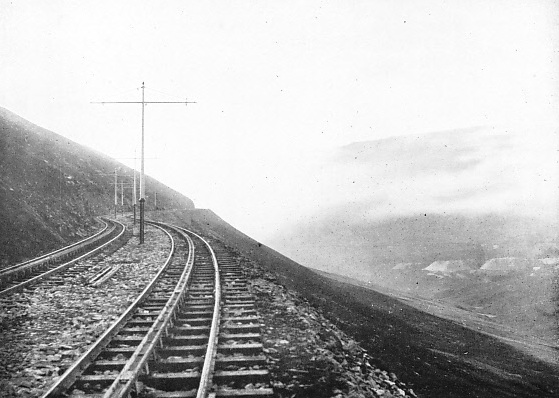
THE SNAEFELL MOUNTAIN TRAMWAY, ISLE OF MAN
This is the only example of the Fell Centre-Rail System in Great Britain.
The advantages and possibilities of the Fell Centre-Rail System are recognised more fully to-day than when the Cenis line was carried out. The big tunnel fever has died down, as such undertakings are exceptionally costly, and in many cases unremunerative. In addition to the suggested double-tracking of the Mont Cenis route by this means, it is proposed to build another connection upon standard gauge trunk road principles through the Monginevra Pass, so as to offer a shorter and quicker route between Turin, Marseilles, the south, and east of France by way of Briancon and Oulx. This mountain railway will be laid on the Centre-Rail System over the Pass, the summit of which is 6,061 feet above the sea, and will be 25 miles in length. The passage of the mountain will occupy about two hours, and the cost of the line will be about £500,000. While the cost of working the line at this elevation will exceed that of operating a tunnel, yet, if this latter charge is capitalised, and added to the cost of construction, the expenditure still will be less than one-half of that involved in driving a tunnel. Another important projected Fell line is that between Civita Vecchia and Terni, in Italy. At the present time, in order to pass between these two points, it is necessary to make a long detour via Rome, which is a severe handicap to the industrial and commercial expansion of Terni. A more direct route to the sea is in urgent request, but it is impracticable with an ordinary locomotive line, owing to the heavy ascent that has to be made from the coast. By means of the Fell railway it will be possible to follow almost an airline from the seaboard to Orte, where the present main line can be rejoined for Terni.
That a method of railway transportation which had established its possibilities, and then had been permitted to lie dormant practically for thirty years, should undergo revival is somewhat unique in railway engineering annals. But it serves to emphasise how hard-pushed the railways are to-day in the struggle to make ends meet. Whereas half a century ago the idea was regarded somewhat as a novelty, to-day it has to be considered in the light of a necessity.
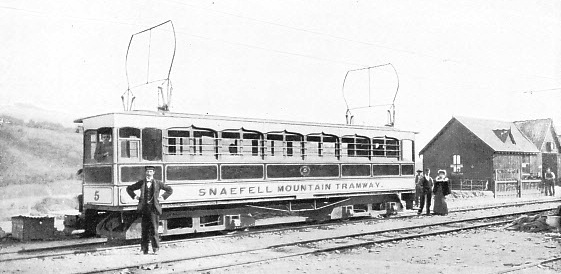
A COACH ON THE SNAEFELL MOUNTAIN TRAMWAY
You can read more on “The Conquest of the Clouds”, “The Crookedest Railway in the World” and “Rack Rail Locomotives” on this website.






 he system of working the traffic through this pass is interesting. As a rule the train is divided into sections, each having its own engine and all coupled together. In this manner each engine is caused to haul its own full load, and the couplings do
he system of working the traffic through this pass is interesting. As a rule the train is divided into sections, each having its own engine and all coupled together. In this manner each engine is caused to haul its own full load, and the couplings do
